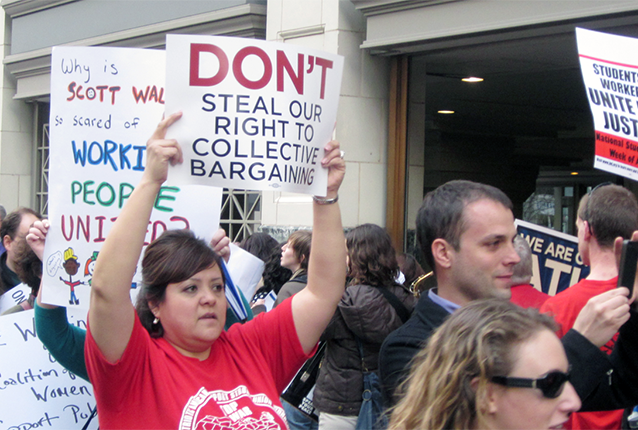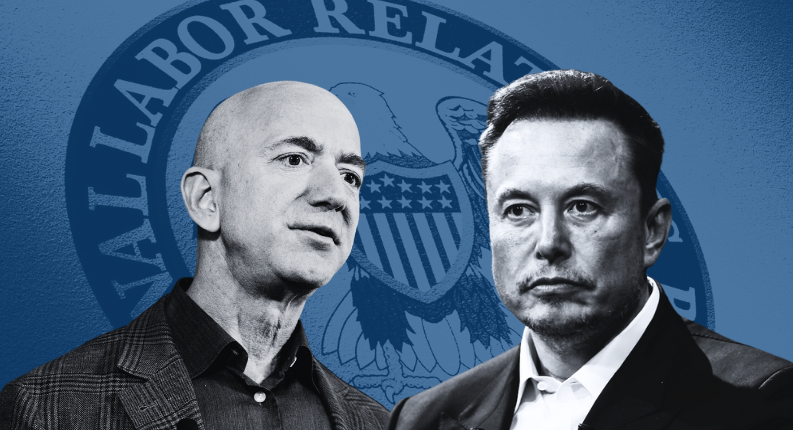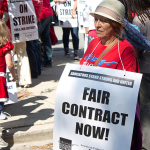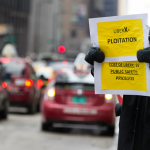This primer on unionbusting answers frequently asked questions about the companies and firms who are set on opposing unions. Check out Unions 101 and Strikes 101 too!
What Is Unionbusting?
The term unionbusting describes the planned course of action to stop workers from organizing a union or to destroy a union already in the workplace. Because federal labor law is woefully outdated and ineffective in protecting and enforcing workers’ rights to form unions, it has become standard practice for employers to block workers’ from freely banding together to have a voice on the job, often through the use of unionbusters.
Why Do Employers Unionbust?
Employers who have a hostile, kneejerk reaction to the possibility of union organizing often deploy aggressive union-avoidance strategies, like hiring unionbusters. Employers often use unionbusters because they fear employees having a meaningful say on hours, pay, benefits and working conditions – a fear sold to them by the unionbusting industry at extravagant seminars and conferences. Our broken U.S. labor law, affording no real deterrent for unlawful conduct, creates an added incentive for employers to engage in aggressive unionbusting. Yet there can be high hidden costs to unionbusting for employers. The intimidating, prying nature of unionbusting campaigns can divide a workplace and may lead to low morale, less productivity and increased turnover. Such unanticipated consequences may negatively impact consumers and stakeholders. Unionbusting also may mean maintaining poor job standards that can drag down working conditions across industries and regions.
Who Are Unionbusters?
Unionbusters are professional consultants or lawyers who may represent a legal consortium or consulting firm and specialize in advising employers on how to thwart union organizing drives or how to decertify unions without (technically) breaking the law. These individuals or firms advertise their ability to manipulate our broken labor law system. Unionbusters usually self-identify as “union avoidance firms,” “management consultants” or “labor consultants.”
Unionbusters offer legal services, advice and consultation, training seminars, workshops and materials for management and supervisors, and a variety of targeted anti-union propaganda for distribution to employees, including videos, posters, leaflets, flyers and giveaways. Unionbusters’ sophisticated advice, training and materials help an anti-union employer create a sense of dissension and division among employees during an organizing campaign and spread misinformation about the union before workers vote in a union representation election. Additionally, these “consultants advise management on how to stall or prolong the bargaining process, almost indefinitely – bargaining to the point of boredom….”1
Why Haven’t I Heard of These Firms?
Unionbusters operate under the radar intentionally. Unionbusters often provide material and instructions behind the scenes to anti-union employers who then direct middle-management and supervisory staff to carry out and distribute the unionbuster’s advice and materials. In this way, the unionbuster does not deal directly with employees and, as a result, may avoid having to disclose financial reports about such activity to the U.S. Department of Labor. The unionbuster’s name or firm is rarely used or referenced in the anti-union materials distributed to employees, further masking the unionbuster’s involvement in orchestrating the anti-organizing campaign. Currently federal law requires little in the way of transparency or reporting, so anti-union employers and consultants have no incentive to divulge specific details about their work or the costs of this practice.
Who Uses Unionbusting Firms?
Employers commonly subject workers to threats, interrogation, harassment, surveillance and retaliation for supporting a union. In fact, 75 percent of employers facing a union organizing drive hire anti-union consultants.2
How Successful Are Unionbusters?
It is no coincidence that as the unionbusting industry has grown the rate of union membership has declined. A unionbuster profiled in Fortune magazine boasted of preventing 32 of 35 of his clients’ organizing drives in one year.3 Unionbusters even go so far as advertising their rates of success. One firm, Labor Relations Institute, now boasts a money-back guarantee on its website: “If your organization purchases an LRI Guaranteed Winner Package and the union becomes certified, the Labor Relations Institute will refund the full cost of the package.”4
What Are Common Unionbuster Tactics?
- Supervisors as Frontline Soldiers: Supervisors, who themselves have no legally protected right to be represented by a union, are often tasked with doing the dirty work of the unionbusters and management. Middle managers and supervisors who have closer relationships with rank-and-file staff are often directed to deliver anti-union letters, speeches and informal talks prepared by unionbusters.
- One-on-One Meetings: During union organizing drives, 77 percent of workers are forced to attend intimidating, closed-door or isolated meetings with supervisors.5 These aren’t friendly impromptu chats, but well-planned meetings designed by unionbusters to decipher employees’ feelings about the union and persuade them against the union.
- Captive Audience Meetings: So-called “captive audience” meetings are held for employees during work hours to disseminate propaganda against union representation and to attempt to discredit the union. Eighty-nine percent of employers hold captive audience meetings during an organizing drive.6 Employees are almost always required to attend, but union organizers may be intentionally disinvited. Often, the meetings are rigged so that workers who are already against the union are assigned to ask questions to sow misinformation.
- Delay: Unionbusters often attempt to delay union representation elections by legal maneuvers so they have more time to implement other tactics needed to increase tension, dissension and the employer’s chance of winning the election.
- Divide and Conquer: Unionbusters manipulate staff dynamics to make employees feel that there is a tense division among staff concerning the union election. They may go so far as to pit one group of employees against each other, based on race or ethnicity.
- Propaganda: Unionbusters often flood employees with heavy-handed letters, cartoons, videos and leaflets to sway them against wanting a union. Seventy percent of companies involved in organizing drives mail anti-union materials to employees’ homes.7 In 2011, Gawker unearthed a video and scare-mongering materials that Target shared with employees who were trying to form a union.
- Love Offerings: In order to convince employees that they don’t need a union, unionbusters may advise clients to provide indirect bribes, like unexpected increases in wages or benefits or “feel good” measures like free food and lottery tickets.
Download the PDF: Unionbusters 101
More Reports and Articles on Unionbusting
The Union Avoidance Industry in the United States
Author: John Logan, London School of Economics, British Journal of Industrial Relations Journal vol. 44, no. 4, December 2006
This brief analyzes the development of “unionbusters,” providing case studies of each of the main groups comprising the industry: law firms, consultants, industry psychologists, and strike management firms. Download: PDF (25 pgs)
Neither Free Nor Fair: The Subversion of Democracy Under the National Labor Relations Board
Author: Gordon Lafer, University of Oregon, American Rights at Work, July 2007
Download this report outlining the how the NRLB has failed to protect the rights of workers when forming a union: PDF (74 pgs)
The Long, Slow Death of Workplace Democracy at the Chinese Daily News
Author: John Logan, London School of Economics, University of California-Los Angeles, 2003
Download this expose about The Burke Group, one of the largest bad actors in the anti-union consultant business, and its role in the war against workers at the Chinese Daily News: PDF (22 pages, 113KB)
Consultants, Lawyers and the ‘Union Free’ Movement in the USA Since the 1970s
by John Logan, London School of Economics, Industrial Relations Journal, vol. 33, no. 3, 2002.
Download this report summarizing unionbusting practices over the last three decades: PDF (18 pages, 155KB)
How Do You Drive Out a Union? South Carolina Factory Provides a Textbook Case
The New York Times profiles union-avoidance firm Jackson Lewis and exposes the lengths an employer will go to, at the advice of a unionbuster firm, to attack workers who attempt to form unions. This case features well-known union-avoidance firm Jackson Lewis.
Sources
1. John Logan, “Consultants, Lawyers, and the ‘Union Free’ Movement in the USA Since the 1970s,” Industrial Relations Journal vol. 33, no. 3, 2002.
2. Kate Bronfenbrenner, “No Holds Barred : The Intensification of Employer Opposition to Organizing,” Economic Policy Institute, 2009.
3. Richard McGill Murphy, “The Persuaders: Peter List and James Hulsizer roar into small businesses to help chase away unions,” Fortune Small Business Magazine, May 2004.
4. Labor Relations Institute, Inc. www.lrionline.com/Products/GuaranteedWinner.html
5. Bronfenbrenner, “No Holds Barred”
6. Ibid.
7. Ibid.








